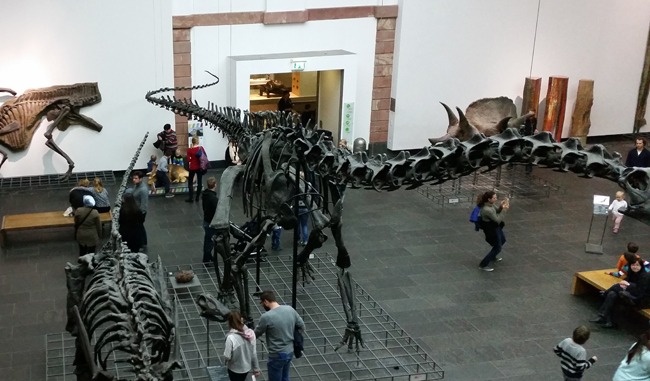Rare Sauropod Femur Discovered In Japan
Huge Sauropod Thighbone Unearthed in Japan
A partial sauropod femur (thigh bone) of a long-necked dinosaur has been discovered by a team of Japanese palaeontologists in Katsuyama, Fukui Prefecture on Honshu island. This is only the second time a sauropod femur has been discovered in Japan. The first thigh bone was unearthed in 1996 in the Kinki region of Japan, on Honshu island but on the Pacific ocean side of the island, whereas as this new find in Fukui Prefecture is from the side of the island that faces the Sea of Japan. The sediments from which this second fossil femur has been extracted have been dated to the Early Cretaceous period about 120 million years ago (Aptian faunal stage).
Sauropod Femur
The bone measures 85 cm long and is believed to have been part of the dinosaur’s right hind leg. The part of the bone that connects to the knee joint is intact (distal end) but the the part attaching this bone to the hips has been corroded away. This fossil site has also provided other fossil material including three typical sauropod-like teeth, a partial rib bone and elements of a sauropod foreleg. As these fossils have been recovered from the same strata as the femur and are in association with the thigh bone, scientists have speculated that all these bones belonged to the same animal.
Sauropod Fossil Bones
Despite the robust nature and huge size of sauropod bones, complete articulated specimens are extremely rare. Even very well known dinosaurs such as Diplodocus are known from only incomplete and partial remains. Lots of the reconstructed specimens and fossil replicas dominating museum entrance halls and exhibitions are actually composites. They have been made up from the remains of several animals. Indeed, when it comes to fitting skulls to these huge exhibits, skulls from completely different genera have been added to complete the look of the specimen.
Sauropod skulls are notoriously rare, this is because they are on the end of a long, articulated neck and during decomposition the head often falls off and is lost in the fossilisation process.
This is why, even large museums have often resorted to putting the head of a different species onto the body of another dinosaur to complete their reconstruction. This has been done partly through mistakes made when it comes to sorting out which skull belonged to which animal and partly through necessity due to the paucity of the sauropod skull record.
A Sauropod Fossil Skeleton on Display at a Museum

A sauropod (diplodocid) skeleton exhibit on display at the Frankfurt Natural History Museum (Naturmuseum Senckenberg). Picture credit: Everything Dinosaur.
Picture credit: Everything Dinosaur
For models and replicas of sauropods and figures of some Japanese dinosaurs: CollectA Age of Dinosaurs Models and Figures.
Although the genus to which this particular Japanese dinosaur belonged cannot be identified from the material found so far, scientist may be able to estimate the size of this animal by studying the proportions of the limb bones of other sauropods.
To read an article on other recent dinosaur discoveries in Japan: Duck Billed Dinosaur Skull found in Japan.

